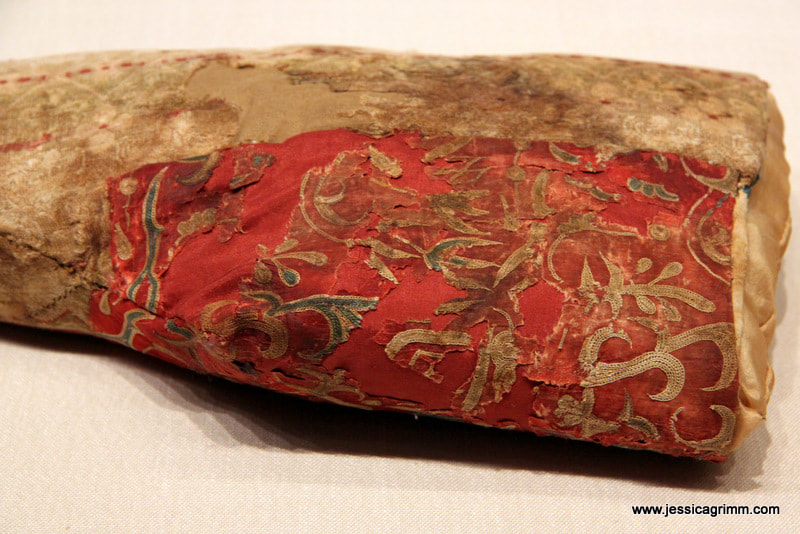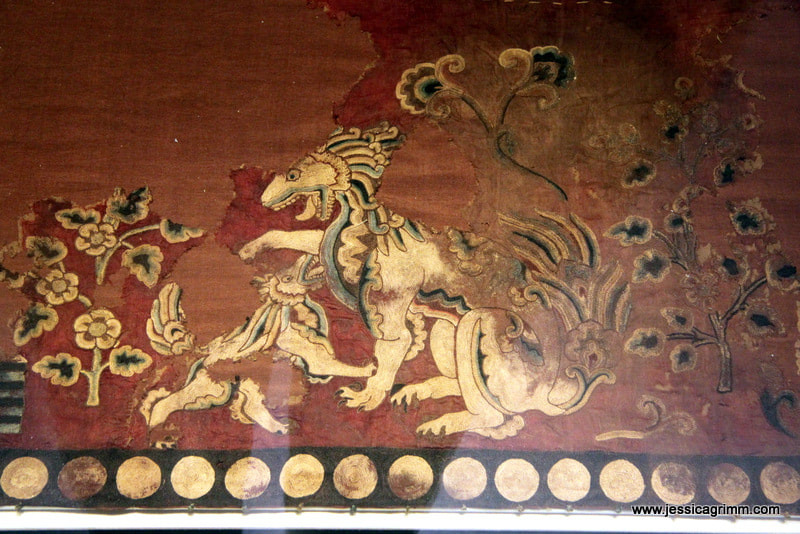|
Two cents for your thoughts when you read the above blog title. Highly likely that you now have a picture of these hyper-realistic silk embroideries in your mind :). But that's not what we are going to explore in this blog post. Chinese embroidery is so much more! There's the intricate and colourful embroidery from the many ethnic minorities we will explore in a future blog post. And then there are these magnificent dragon robes worn by the emperor and his close relatives. Equally food for a future blog post. But how did it all began? A question I never really asked myself before I went to China. As an archaeologist I am all too aware that the evidence we have for really old textiles adorned with embroidery is scant. You need very favourable preservation conditions for them to survive. So the mantra instilled in me as an archaeology student: absence of evidence is not the same as evidence of absence, holds very true in the case of ancient textiles. But traveling to China and talking to Chinese embroiderers, the question of how it all began is paramount to them. The humiliation at the hands of the Western powers in the 19th century is still a national trauma. Being the inventor of something which was subsequently adopted by the West, thus counts! The National Silk Museum in Hangzhou has a very modern exhibition on the textiles form the Silk Road. The exhibition includes many textile fragments from recent large scale excavations of tombs. A new exhibition titled 'Countless stitching and marvellous threads' was opened when I taught my workshop at the end of October. Unfortunately, this exhibition has no captions in English (unlike the Silk Road exhibition which is entirely bi-lingual). From what my phone was able to translate, the new exhibition focusses on stitches and how they emerged and developed. Starting with archaeological remains and ending with modern embroideries by contemporary masters. Taking pictures of the embroideries on display posed its own problems. The lighting was understandably dim and flash equally understandably not allowed. Usually not a problem when you are patient and have a steady hand. What was a problem, was the bad quality glass used for the display cases. And the fact that they were very (I mean VERY) dirty from the touching of countless hands. China is this delightful combination of a developing country and a highly digitally developed world nation. This means that they laughed at me when I explained that in my rural village of 1200 people, probably 600 or so don't have a mobile phone, nor an email address. Digital 'illiteracy' is high here and not only among the elderly. At the same time, all 1200 of us would shake our heads in pity at the many Chinese who don't have a private toilet in their home and need to use the public toilet. How to use a museum is something they are in the process of figuring out :). Let's explore the embroideries! The oldest embroideries on display, date to the period of the Han Dynasty (206 BC-220 AD) and the Northern Dynasties (386-581 AD). However, in the publications on embroidery I bought at the museum, it is stated that embroidery already existed in the Xia dynasty (2200-1800 BC). But, this is from oral tradition rather than archaeological finds. The first archaeological evidence seems to date from the late Shang dynasty, around 1300 BC. The above fragment dates from the much later Han Dynasty (206 BC-220 AD) and shows longevity symbols stitched with several colours of silk using chain stitch on a red silk background. This small fragment is all that is left from an all-over embroidered female dress. Other embroidered items include a pair of red socks from the first-third century AD. The stitch used seems to be very fine chain stitch. And here is a piece with goldwork embroidery (couching) depicting animal masks and dating to the Northern Dynasties (386-581 AD). This very large piece depicting lions dates from China's golden age, the Tang dynasty (7th century AD). This lovely piece is an embroidered leather pouch with twill damask and samite border. It dates to the Liao dynasty (907-1125 AD). The upper part is a twill damask border, the middle is of leather, completely covered with chain stitch embroidery, with different patterns on each side: birds, butterflies and peonies on one side and flying birds and hunting motifs on the other.
P.S. If you are interested in the history of Chinese embroidery, I recommend the book 'Silken Threads. A history of embroidery in China, Korea, Japan and Vietnam' written by Young Yang Chung in 2005, ISBN 0-8109-4330-1. This is an epic volume with beautiful pictures and of the highest scientific standard.
18 Comments
3/12/2018 13:33:41
Glad you liked it Meri! I think this is a very interesting field of research which will have many surprises in store.
Reply
Christine
3/12/2018 16:24:50
Fascinating. Thank you for posting
Reply
Tineke
3/12/2018 17:33:12
Wat een fascinerende tentoonstelling en informatie, leuk, dank je wel
Reply
5/12/2018 11:13:52
It sure did, Catherine! Although as an archaeologist I would probably panic the moment I saw textile coming out of the ground :). Excavating it properly and transporting it off to the lab isn't easy!
Reply
5/12/2018 14:35:35
Very interesting article. Young Yang Chung's book has been on my wishlist for a while now but so expensive. I'll have to see if I can find it at my local library.
Reply
5/12/2018 15:53:20
Thank you Dima! The book is worth every penny and I was lucky to putchase mine shortly after it was published and paid €78. I was shocked to see that a new one on Amazon goes for $186. However, the used copies start at $70!
Reply
Susan B Farmer
14/5/2022 23:19:05
My mother bought me a copy of Silken Threads for my birthday a couple of years ago. Loved your article! Was there a museum catalog for this exhibit?
Reply
18/5/2022 13:22:26
There is a museum catalogue titled: Countless Stitching and Marvelous Threads. Only very simple summaries in English and pictures are low quality. No close-ups. Can't help you with the Rozashi embroidery as this is outside my area of expertise.
Reply
Susan B Farmer
19/5/2022 22:45:44
Thank for the useful information.
Reply
Susan B Farmer
18/10/2022 20:58:12
Oh, I do wosh you still had your pinterest boards!
Reply
Hayat
14/11/2022 16:41:09
thanks for this information and im amazed an inspired by your curiosity!
Reply
16/11/2022 17:46:05
Sorry, Hayat, I no longer have a Pinterest account. I've updated the blog post by removing that section. Thank you for alerting me to this issue!
Reply
Your comment will be posted after it is approved.
Leave a Reply. |
Want to keep up with my embroidery adventures? Sign up for my weekly Newsletter to get notified of new blogs, courses and workshops!
Liked my blog? Please consider making a donation or becoming a Patron so that I can keep up the good work and my blog ad-free!
Categories
All
Archives
July 2024
|
Contact: info(at)jessicagrimm.com
Copyright Dr Jessica M. Grimm - Mandlweg 3, 82488 Ettal, Deutschland - +49(0)8822 2782219 (Monday, Tuesday, Friday & Saturday 9.00-17.00 CET)
Impressum - Legal Notice - Datenschutzerklärung - Privacy Policy - Webshop ABG - Widerrufsrecht - Disclaimer
Copyright Dr Jessica M. Grimm - Mandlweg 3, 82488 Ettal, Deutschland - +49(0)8822 2782219 (Monday, Tuesday, Friday & Saturday 9.00-17.00 CET)
Impressum - Legal Notice - Datenschutzerklärung - Privacy Policy - Webshop ABG - Widerrufsrecht - Disclaimer












 RSS Feed
RSS Feed